Physical Address
304 North Cardinal St.
Dorchester Center, MA 02124
Patients with breast concerns that cannot be adequately managed in primary care should be referred to a specialist breast clinic. This has traditionally been run by surgeons but is now a multidisciplinary enterprise. These clinics can perform a combination of clinical, radiological and pathological examinations. Assessment of a breast lump usually requires triple assessment.
![]() Triple assessment is the combination of clinical, radiological and pathological evaluation of a breast lump. Triple assessment should be used in all patients with a solid breast lump or asymmetric localised nodularity and may be relevant in women with other symptoms. Imaging assessment consists of mammography in those aged 40 or over and ultrasonography for all palpable and other significant radiological findings requiring further study. Histological assessment usually involves core biopsy.
Triple assessment is the combination of clinical, radiological and pathological evaluation of a breast lump. Triple assessment should be used in all patients with a solid breast lump or asymmetric localised nodularity and may be relevant in women with other symptoms. Imaging assessment consists of mammography in those aged 40 or over and ultrasonography for all palpable and other significant radiological findings requiring further study. Histological assessment usually involves core biopsy.
This combination of clinical and imaging assessment with core biopsy increases the reliability of determining the cause of an abnormality. It is recommended that all elements of the assessment process are reported on a scale of 1–5 with increasing concern of malignancy ( Table 2.1 ). The availability of clinical and radiological assessment and biopsy at a single clinic visit (‘one-stop’ clinics) is the standard of care for assessing those referred with breast problems. Immediate reporting of cytology from fine-needle aspirates or touch preparation cytology from core biopsy specimens or frozen section of core biopsy specimens is possible in some centres, but given the inability of cytology to differentiate invasive from in situ cancer, this is no longer recommended.
| 1 | Normal (or inadequate cytology) |
| 2 | Benign (or normal cytology) |
| 3 | Suspicious but probably benign |
| 4 | Suspicious and probably malignant |
| 5 | Malignant |
In the USA and European countries, the Breast Imaging Reporting and Data System (BI-RADS) scoring system is used for radiology ( Table 2.2 ). The key difference between the UK and US classifications is that all benign looking lesions would be biopsied in the UK rather than offered short-term follow-up, as they are in the USA.
| BI-RADS score | Classification |
|---|---|
| 0 | Incomplete imaging – further information required |
| I | Negative |
| II | Benign findings |
| III | Probably benign, short interval follow-up suggested |
| IV | Suspicious abnormality and biopsy recommended. Further subdivided into IVa: low level of suspicion for malignancy IVb: intermediate suspicion for malignancy IVc: moderate suspicion for malignancy |
| V | Highly suggestive of malignancy |
| VI | Known biopsy proven malignancy |
It is important to classify the level of concern independently on clinical examination, imaging and histology. This allows the clinician to determine if all the components of triple assessment are concordant or not. The results of all patients undergoing biopsy should be discussed in a multidisciplinary setting to ensure concordance of findings and minimise the chances of missing a breast cancer ( Table 2.3 ).
| Clinical examination | Mammography | Ultrasonography | Fine-needle aspiration cytology | Core biopsy | |
|---|---|---|---|---|---|
| Specificity for cancer | 86% | 86% | 85% | 95% | 90% |
| Specificity for benign disease | 90% | 90% | 88% | 95% | 95% |
| Positive predictive value for cancer | 95% | 95% | 90% | 99.8% | 100% |
A history of the duration and nature of the presenting symptom is taken from the patient. Further specific details can be of value for certain symptoms and are outlined below. Any past personal or familial breast problems should be recorded. General factors such as past medical history, drugs and allergies should be recorded. Hormonal risk factors for cancer such as age of menarche and menopause, parity, age of first birth, breastfeeding, oral contraceptive or hormone replacement therapy use are traditionally documented for epidemiological purposes, although they are of no specific value in achieving a diagnosis in an individual case.
The history and examination findings should be recorded legibly and contemporaneously in the medical records and this is aided by the use of a standard form.
Breast examination ( Fig. 2.1 ) should be conducted in a good light with the patient stripped to the waist and in the presence of a chaperone. Examination of the male breast is similar, with particular attention paid to whether an abnormality is present within the breast tissue or whether the problem being complained of is breast tissue.
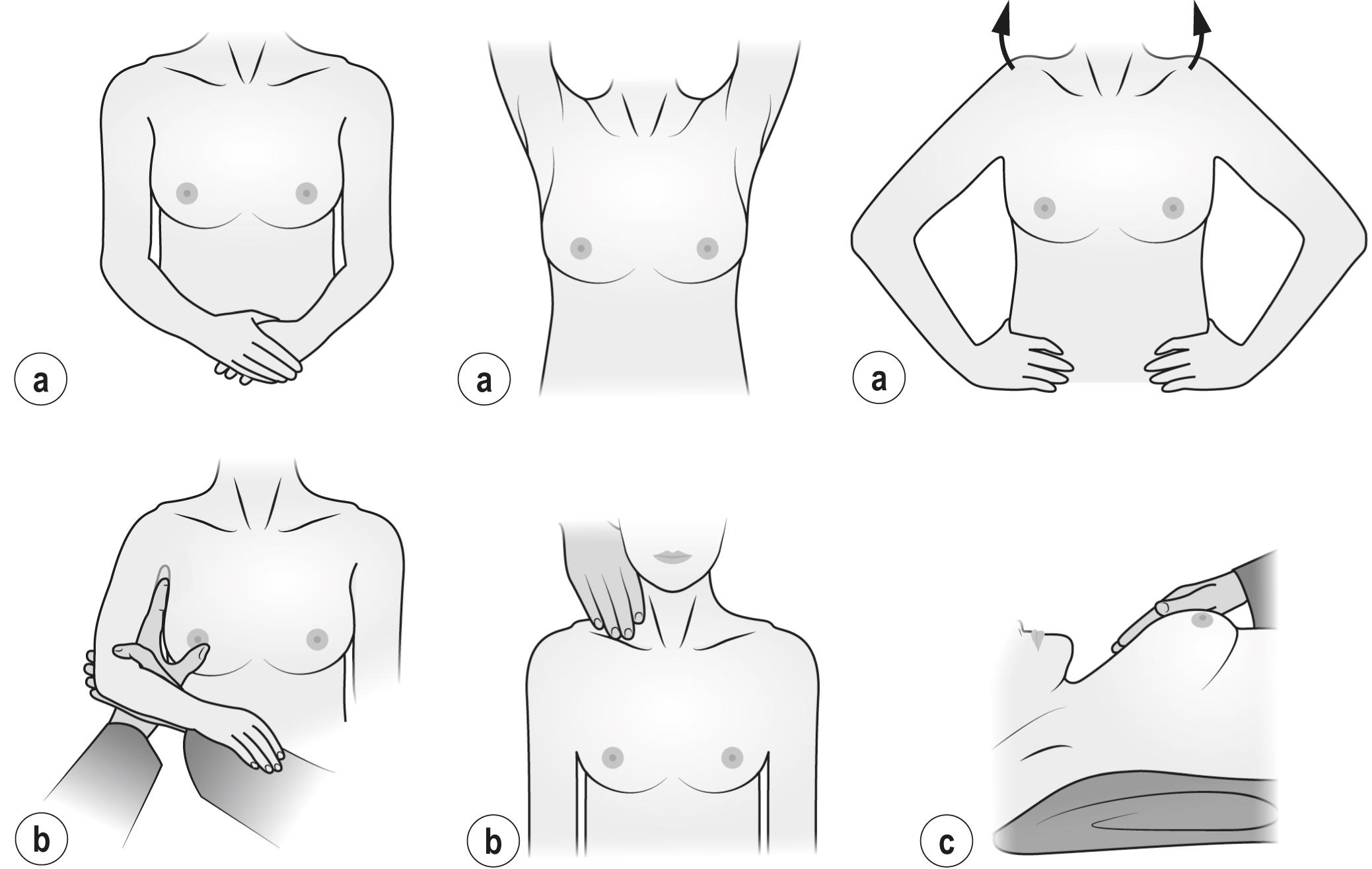
Initial examination is by inspection with the patient in the sitting position with hands by the side, paying particular attention to symmetry, nipple inversion, skin changes and any alteration of breast contour. The breast should also be inspected both with arms raised and with the chest wall muscles tensed to show changes in the dynamic setting.
Palpation of the breasts is best performed in the supine position with the head supported and the arms above the head. Putting the hands above the head spreads the breast out over the chest wall and reduces the depth of breast tissue between the examiners hands and the chest wall and makes abnormal areas much easier to detect and define. All of the breast tissue is examined using the fingertips. If an abnormality is identified, then it should be assessed for size, contour, texture and any deep fixation. All palpable lesions should be measured with callipers and location and size clearly recorded.
If there is a history of nipple discharge, the nipple should be gently squeezed to determine whether a pathological discharge is present. Careful note should be taken of whether the discharge is emerging from single or multiple ducts, and whether blood is present (either frankly or on dipstick testing).
All women complaining of breast pain or tenderness should be examined for tenderness of the chest wall ( Fig. 2.3 ). With the patient in the sitting position, the hand may be pushed up behind the breast from below with pressure on the chest wall. The patient may also be rolled onto their side, allowing the breast to fall medially, exposing the edge of the pectoral muscle to palpation. With the patient sitting or on their side, pressure can be placed on the breast tissue alone between the examiner’s two hands to provide a contrast with pressure on the chest wall. The patient should be asked to indicate if there is any localised tenderness on palpation of the chest wall and whether any discomfort evident during examination is similar to the pain they normally experience. Allowing the woman herself to confirm that the site of maximal tenderness is in the underlying chest wall rather than the breast is effective in reassuring patients that there is no significant breast problem.
The axilla is best examined with the patient sitting. The examiner’s ipsilateral arm supports the patient’s arm while the examiner’s contralateral hand is placed high in the axilla on the chest wall and runs carefully downwards.
The supraclavicular fossa is examined from behind, with the patient in a sitting position.
A general examination of the cardiovascular and respiratory systems is useful in those in whom surgery is being contemplated. If metastatic disease is suspected then examination for bony tenderness, hepatomegaly and pleural effusion may be valuable.
The association between symptoms and cancer risk is indicated in Table 2.4 .
| % of referrals | % with cancer | % of cancers | |
|---|---|---|---|
| Lump | 63.8 | 16.6 | 80.5 |
| Pain | 17.1 | 4.2 | 5.1 |
| Nipple discharge | 4.4 | 5.4 | 1.7 |
| Change in shape | 2.5 | 38.1 | 6.8 |
Concern over a possible breast lump is the commonest reason for referral to a symptomatic breast clinic. More than 90% of all patients who attend such clinics and more than 80% of those referred with a lump will not have cancer.
All patients with a localised abnormality (lump or localised nodularity) require triple assessment. Distinguishing an area of normal breast nodularity from a pathological lump clinically can be difficult. This is particularly important in young women with breast cancer who may present with localised nodularity rather than a discrete mass. Aspiration of symptomatic breast cysts is usually offered but needling of all unequivocal cysts is not necessary.
The likely cause of a lump varies markedly with age. Fibroadenomas are typically found in the teens and twenties, cysts in the mid to late forties, with cancer becoming the most common cause of a lump in women over 50.
Fig. 2.2 summarises the procedure for the investigation of a lump.
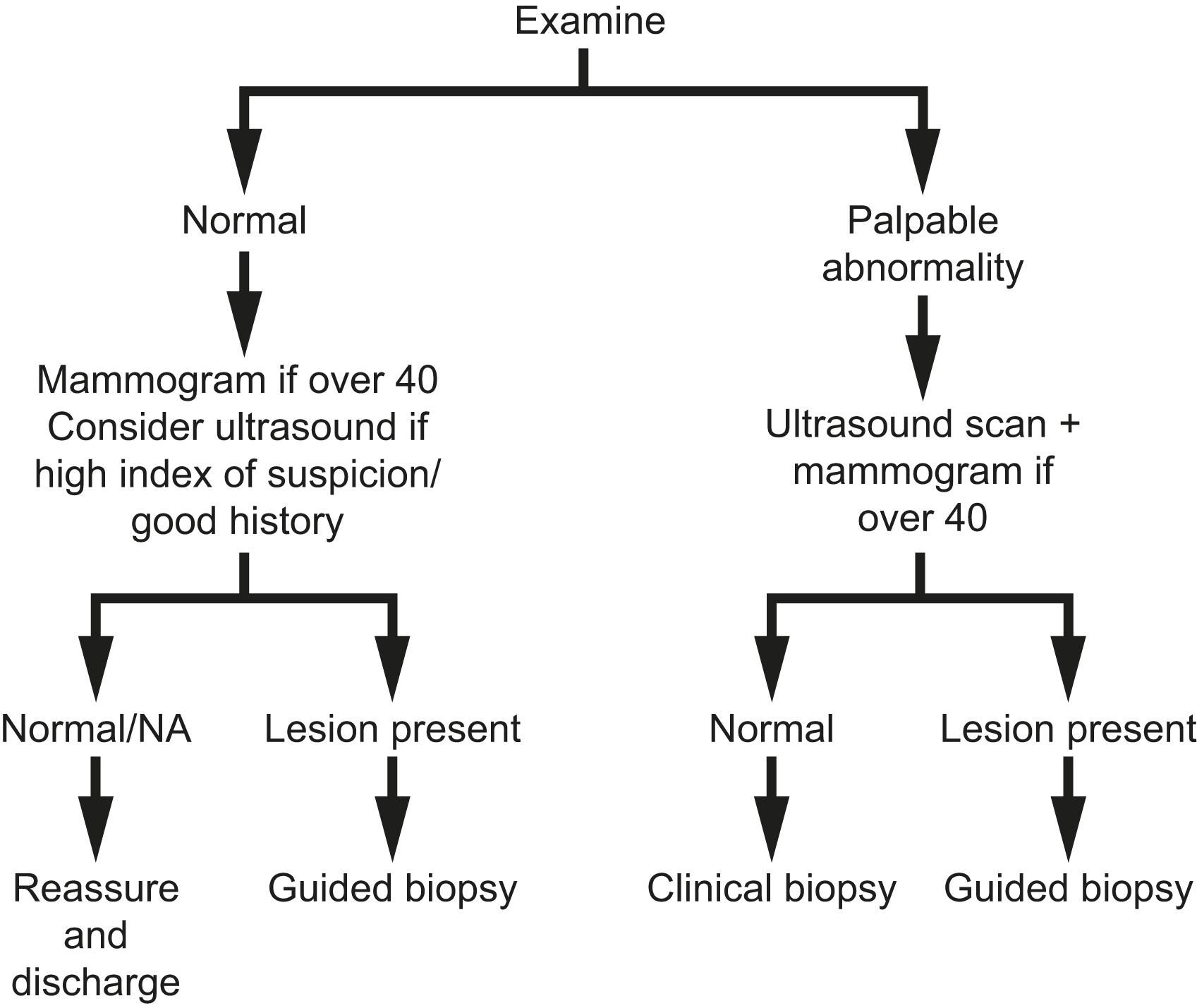
Common causes include lymph nodes, skin lesions and accessory breast tissue. Ultrasound will characterise nodes in the majority of cases. A history of skin problems or recent systemic illness will often explain innocent-looking nodes. If nodes are suspicious, imaging of the breast, survey of the skin in the draining area for lesions such as melanoma and examination of other lymph node areas should be performed. Biopsy of concerning nodes is required. A suspicion of lymphoma may require surgical excision to allow full histological analysis. Prominent nodes are increasingly a cause of recall from breast screening.
Pain related to the breast is a common cause of referral but an uncommon sign of cancer. If cancer is diagnosed it is usually an incidental finding and not the cause of the pain. The most common causes of pain in the breast are musculoskeletal chest wall pain and cyclical breast pain. These are usually easily distinguished by the history and careful examination. Treatment is often unsatisfactory and largely symptomatic but explanation of the symptoms and reassurance are helpful ( Fig 2.3 ).
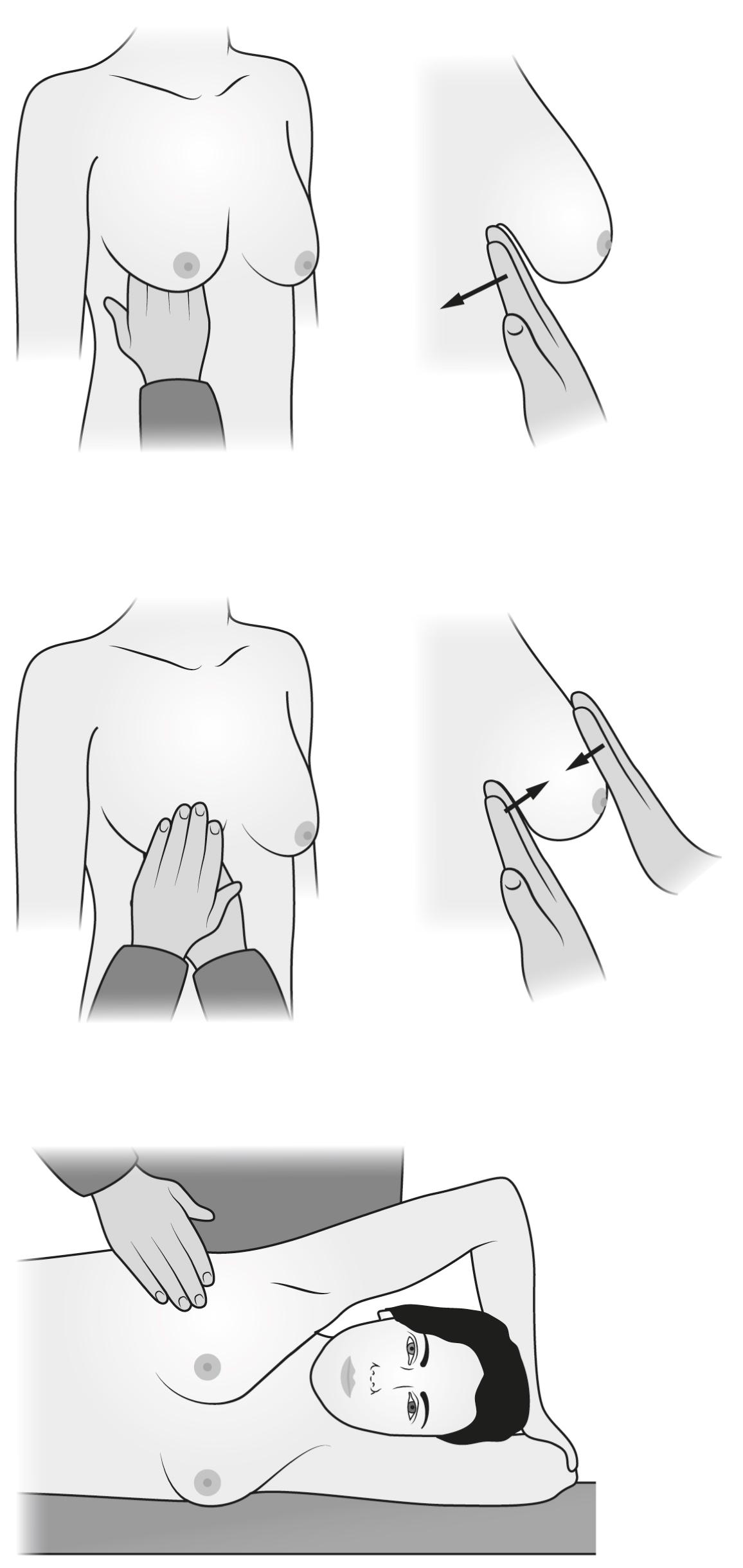
Nipple discharge accounts for 5% of all symptomatic breast clinic referrals and is usually innocent. Important elements of the history are the nature of the discharge, whether the discharge is spontaneous or provoked, whether it is troublesome and any medications being taken. Examination and appropriate imaging are required. Palpable or radiographic abnormalities must be addressed on their own merits.
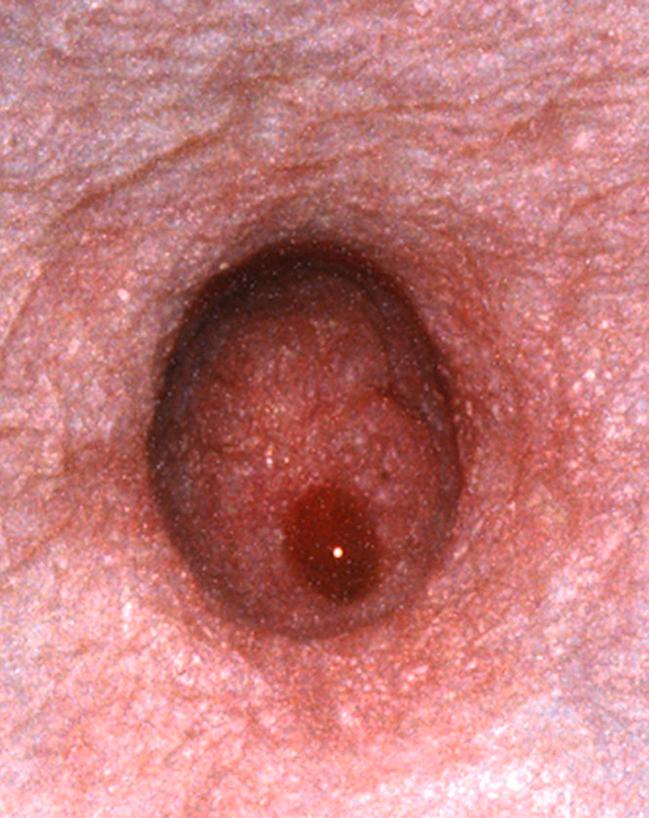
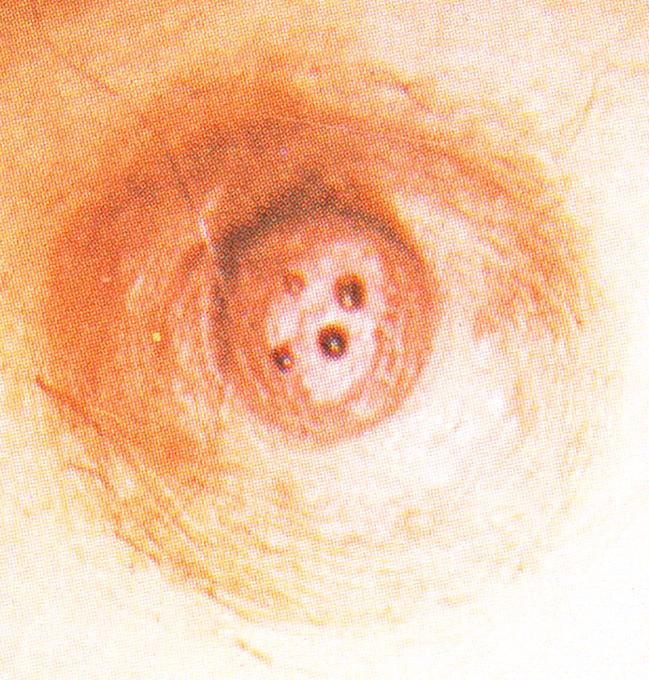
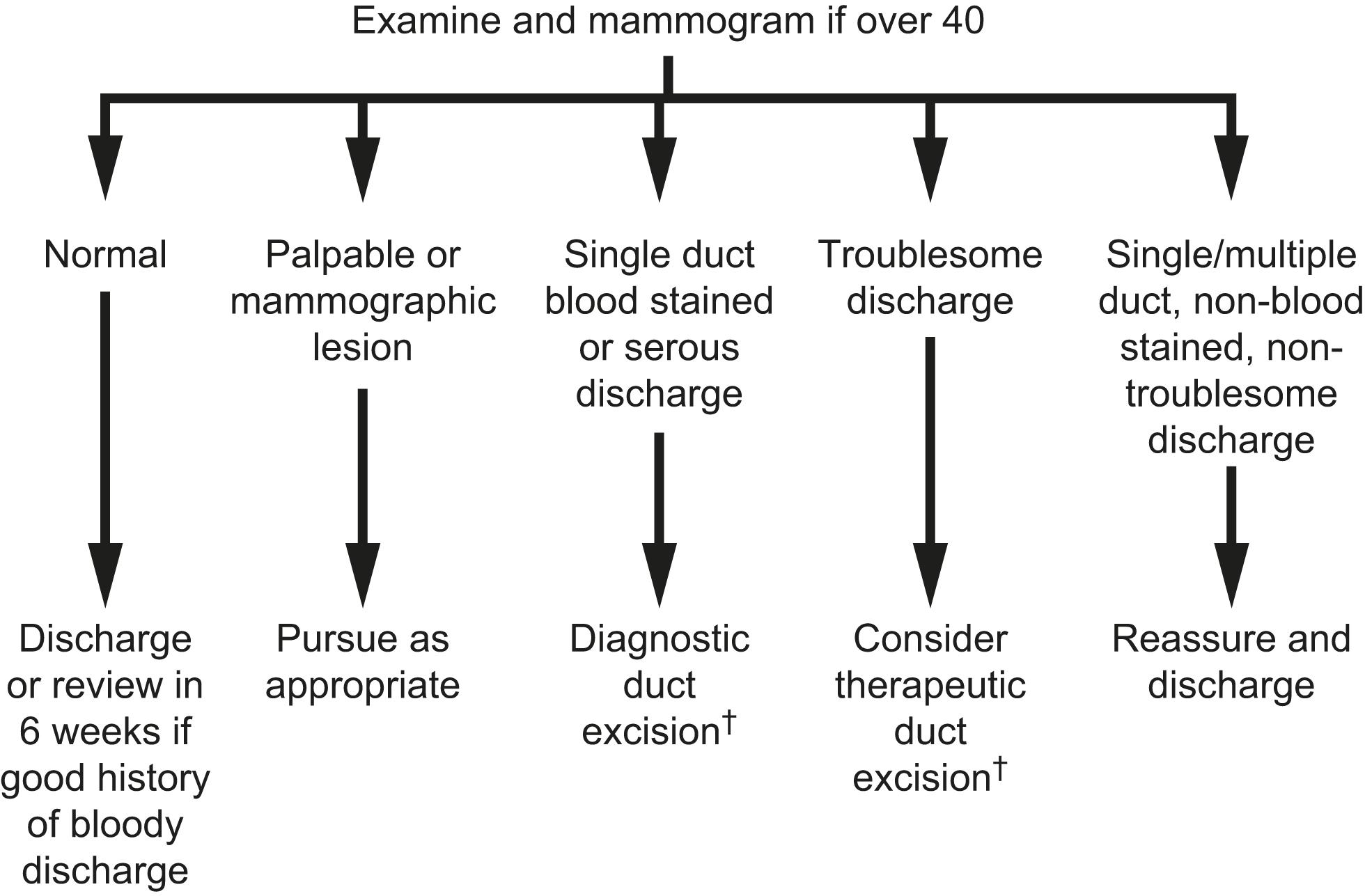
The majority of patients with multiple duct discharge have so-called physiological nipple discharge or duct ectasia (a normal aging change).
True galactorrhoea, a copious bilateral milky discharge not associated with pregnancy or breastfeeding, is rare and usually drug induced. In galactorrhoea with no obvious cause, prolactin levels should be checked and if pathologically raised, scanning of the pituitary for a prolactin-secreting tumour should be considered.
Features of nipple discharge which raise suspicion of an underlying malignancy include discharge which is copious in amount (regularly stains clothes), is persistent, is bloodstained or contains moderate or large amounts of blood on dipstick testing and emerges from a single duct. The older the age of the patient, the higher the concern, but malignant changes can be seen in all ages of women with discharge. The majority of patients with troublesome, single-duct, blood-stained nipple discharge have benign causes, the most common being intraduct papillomas and duct ectasia. Nipple cytology has a low sensitivity and has no role in routine management. Visual examination of the ducts is possible using a fibreoptic endoscope around 1 mm in diameter with a working channel to allow biopsy or washings for cytology. This technique has its enthusiasts but is time-consuming, requires specific equipment and expertise and does not often preclude the necessity of surgery for treatment.
Duct excision is recommended for definitive diagnosis in all women with significant discharge. In women who are postmenopausal or who are not planning to have more children, total duct excision can be performed, but in younger women, excision of just the affected duct allows these women to breastfeed after surgery. Surgery involves a short incision at the areolar margin, division of the ducts just behind the skin at the back of the nipple and excision of the underlying ducts for 2–3 cm into the breasts. Note should be taken of any serous or bloodstained discharge seen entering the cavity on division of the proximal ducts. Any such concerning discharge from the divided proximal ducts should be pursued by further excision of the affected area to ensure more proximal lesions are not missed. In those women wishing to breastfeed further children, excision of the affected duct alone (microdochectomy) can be considered. The affected duct can often be identified by cannulation with a probe prior to the incision. This technique minimises damage to other ducts.
Benign nipple retraction ( Fig. 2.7 ) is common and has a characteristic symmetrical appearance with a central horizontal slit. In such patients the nipple can usually be manipulated by tension on the areolar margin to evert it. Malignant nipple inversion ( Fig. 2.8 ) is often eccentric rather than central; the nipple cannot be manually everted and is usually seen in association with other signs of malignancy.
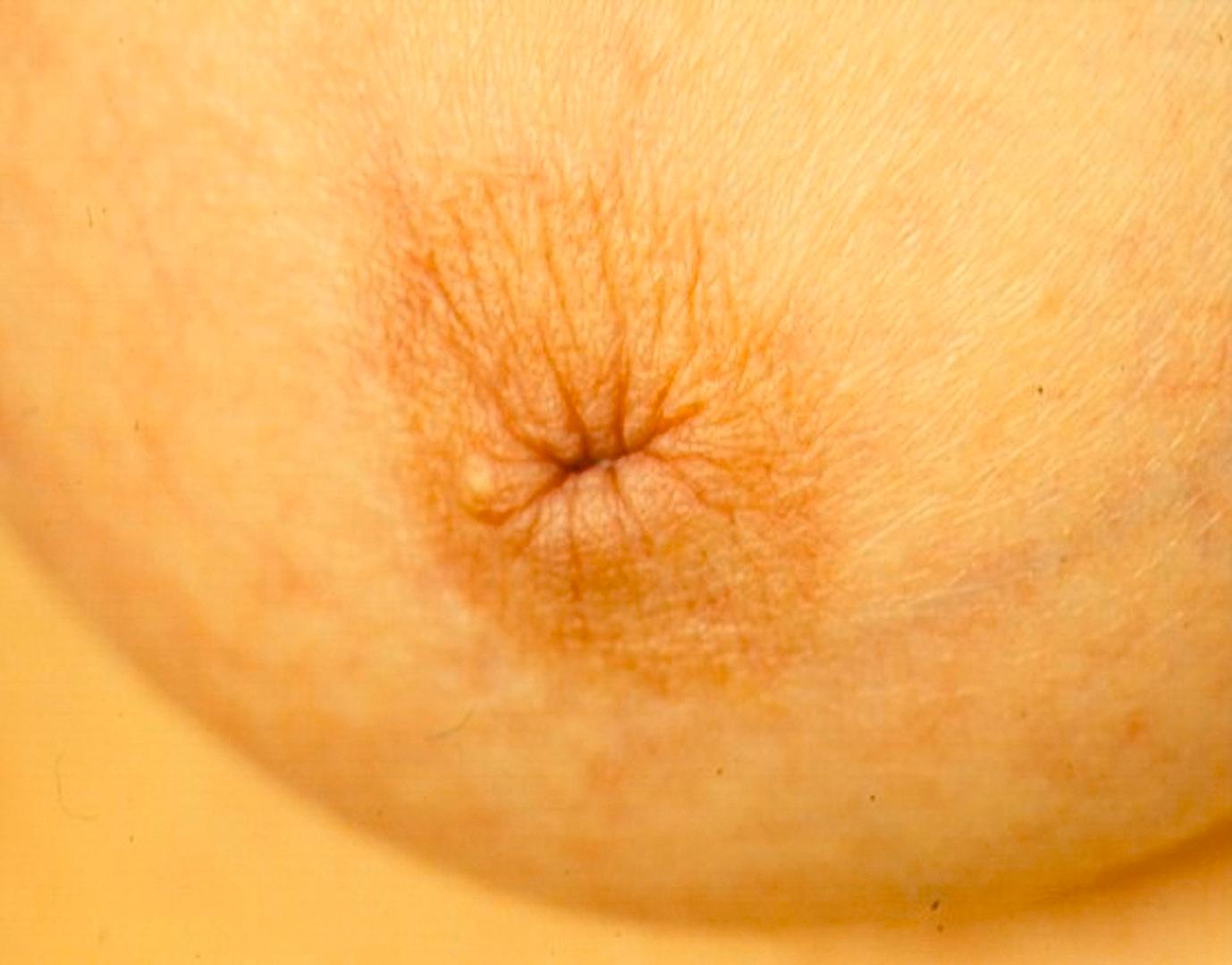
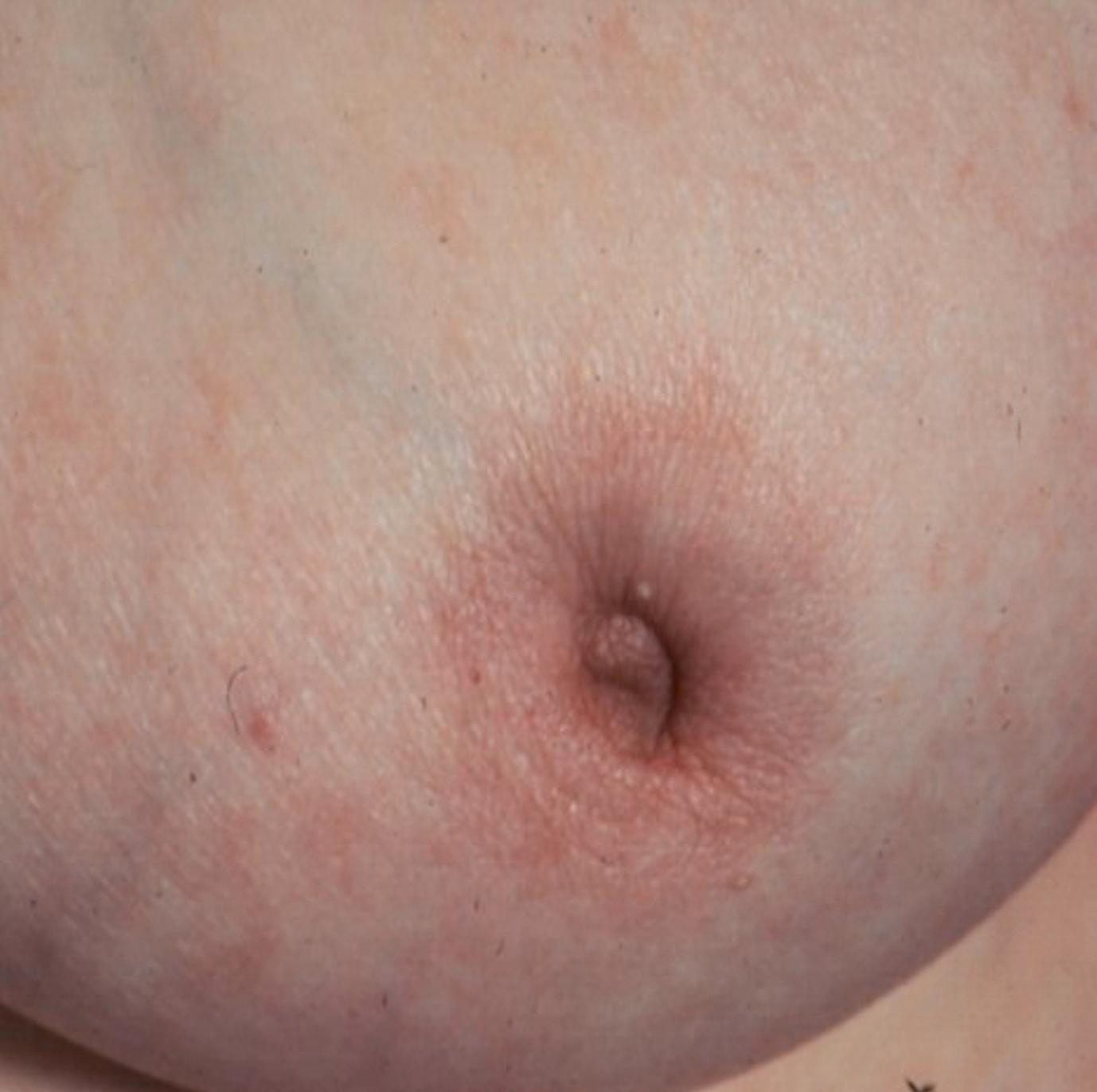
A degree of breast asymmetry is normal but a significant asymmetry following breast development may require plastic surgical techniques to correct. Changes in breast contour are uncommon but are not infrequently associated with underlying malignancy due to distortion of the connective tissue framework of the breast by the cancer. Fat necrosis following trauma (including surgical trauma) may give rise to skin dimpling ( Fig. 2.9 ) and lumps. Mondor’s syndrome ( Fig. 2.10 ), due to thrombosis of dermal vessels, can result in linear dimpling and may be palpable. Atrophy of the breast with age can also lead to irregularities of breast contour. Careful clinical assessment and imaging with a high degree of underlying suspicion are recommended.
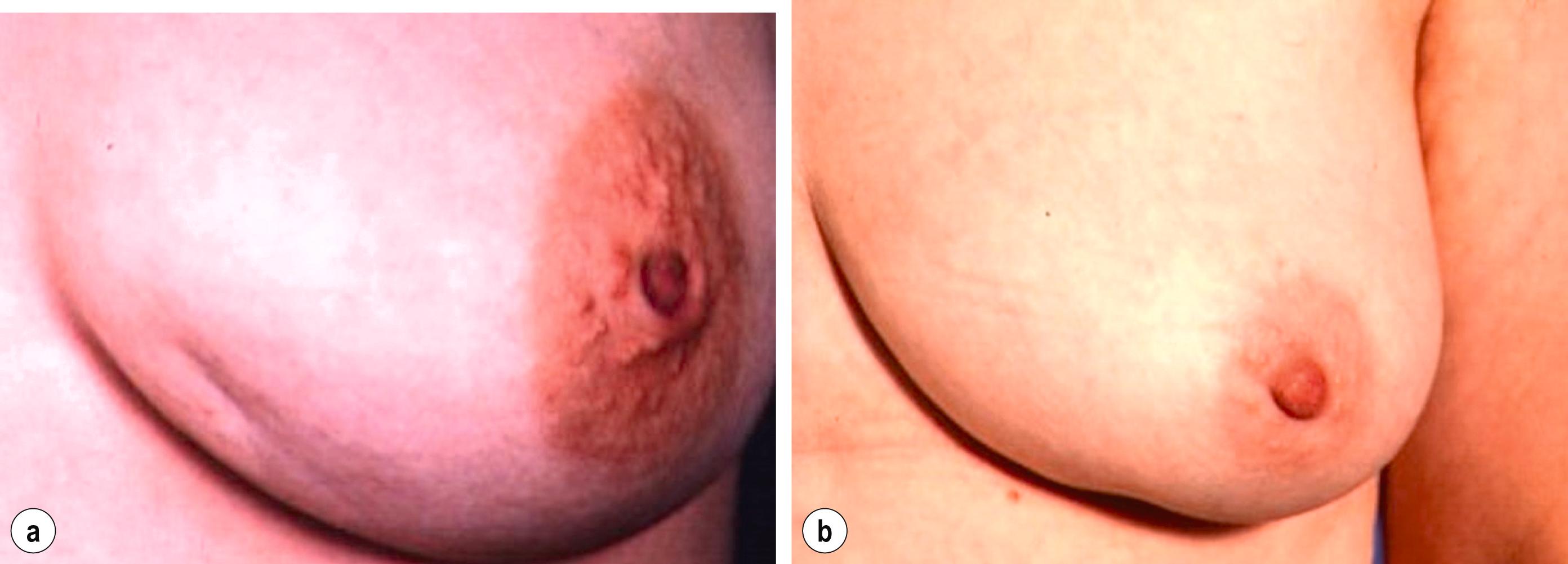
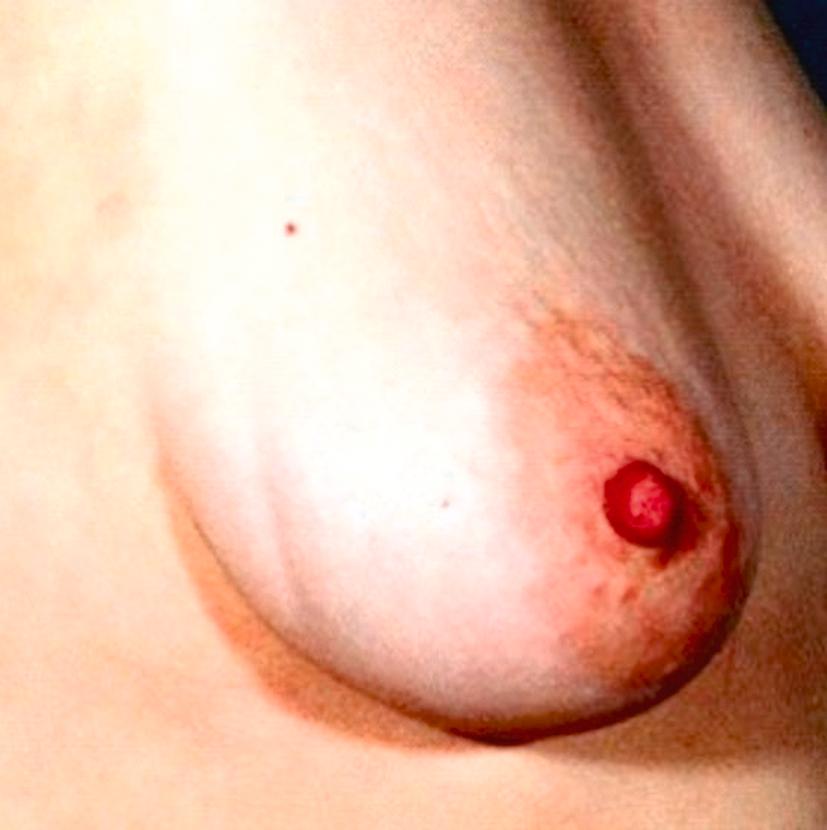
The skin of the breast is susceptible to the full range of dermatological conditions including eczema, naevi and epidermal inclusion cysts. Skin cancers may also occur on the breast.
Paget’s disease of the nipple arises when malignant cells involve the epithelium of the nipple skin resulting in a red, scaling appearance which can sometimes be difficult to differentiate from eczema. Paget’s disease always involves the nipple but may also spread beyond the nipple to involve the surrounding areolar area. Eczema starts on the areola and usually spares the nipple itself. If there is concern that Paget’s disease is present, a punch biopsy or a core biopsy including nipple skin should be performed under local anaesthetic in the outpatient clinic. If Paget’s disease is confirmed, further investigation is required to determine whether underlying ductal carcinoma in situ (DCIS) or invasive malignancy is present.
Breast cancer can directly invade the skin of the breast or nipple, resulting in a hard pink lump or ulceration. Metastatic tumour nodules within the skin but distant from the primary breast cancer may also be seen. Blockage of skin lymphatics by breast cancer cells results in breast oedema producing a peau d’orange appearance. Erythema is a feature of so-called inflammatory cancer.
Gynaecomastia is due to hyperplasia of the glandular tissue of the male breast. It is common, particularly in newborns, teenage boys and old men, when it is due to physiological hormonal changes. It can be a source of embarrassment. Care should be taken to differentiate it from pseudogynaecomastia due to accumulation of fat in the breast area without glandular development.
Gynaecomastia is due to a relative imbalance of androgen and oestrogen ( Table 2.5 ) and is thus a manifestation of a systemic issue rather than a specific breast problem. Assessment must therefore address potential systemic causes as well as ensure that there is no local problem with the breast tissue. Breast lumps must be investigated as such. Lumps not involving the breast tissue such as lipomas are not uncommon in men.
| Decreased androgens |
| Chromosomal abnormalities – e.g. Klinefelter’s syndrome |
| Testicular failure – cryptorchism, torsion, orchitis |
| Renal failure |
| Androgen resistance – testicular feminisation |
| Increased oestrogens |
| Increased secretion – testicular tumours, lung cancer |
| Increased aromatisation – liver disease, obesity, adrenal disease, hyperthyroidism |
The aetiology of gynaecomastia can often be determined from the history. Enquiries should focus on factors associated with the condition such as liver disease, testicular problems and drugs (including recreational drugs such as alcohol, cannabis, opiates and anabolics) ( Table 2.6 ). The impact of the gynaecomastia on the patient is worth exploring. Some men are not concerned and therefore may require no intervention; others become haunted by it and are desperate for treatment.
| Hormones – anabolics, androgens, antiandrogens, oestrogenic agents |
| Recreational drugs – alcohol, cannabis, heroin, methadone, amphetamines |
| Cardiovascular drugs – digoxin, spironolactone, ACE inhibitors, amiodarone, calcium channel blockers |
| Antiulcer drugs – H 2 receptor blockers, proton pump inhibitors |
| Antibiotics – ketoconazole, metronidazole, minocycline, antiretrovirals |
| Psychoactive agents – tricyclics, diazepam, phenothiazines |
| Others – domperidone, metoclopramide, penicillamine, phenytoin, theophylline, allopurinol |
Examination should include a general examination (for signs of liver/hormonal problems), examination of breast tissue, axillary lymph nodes and testes ( Fig. 2.11 ). Feeling testicular tumours is rare, but atrophic or even an absent testicle may be noted, limiting the need for further investigation. The extent of gynaecomastia can be classified according to the extent of breast tissue and redundant skin ( Table 2.7 ).
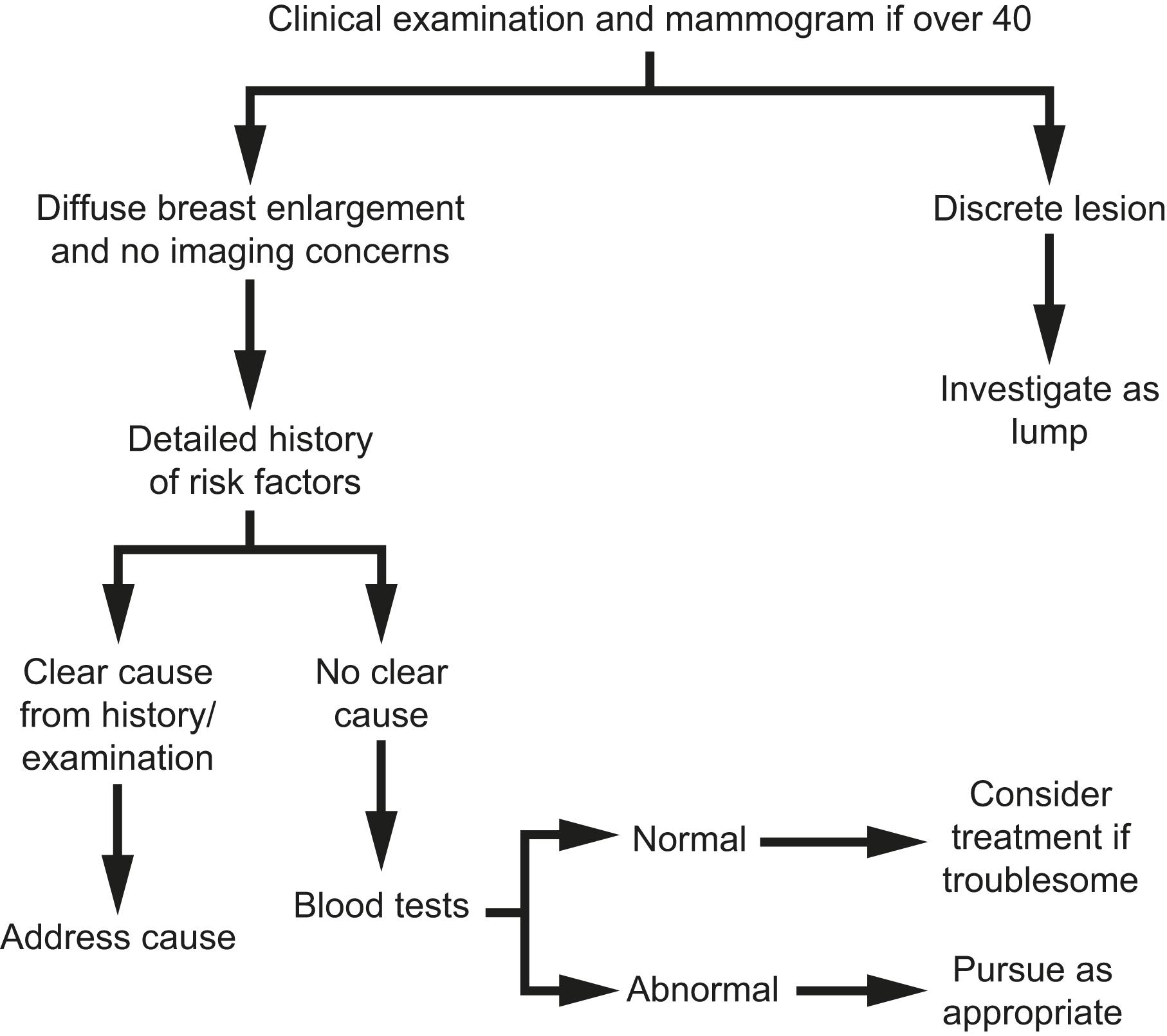
| Grade | Appearance |
|---|---|
| I | Small development of breast but no excess skin |
| IIa | Moderate breast development with no excess skin |
| IIb | Moderate breast development with excess skin (nipple at or above inframammary fold) |
| III | Marked breast development with excess skin (nipple below inframammary fold) |
In those aged between 18 and 60 without an obvious cause from the history and examination and significant enlargement of breast tissue (not just fat), the following blood tests are recommended – urea and electrolytes, liver function tests, luteinising hormone, follicle stimulating hormome, testosterone, prolactin, alphafetoprotein and beta human chorionic gonadotrophin.
Mammograms can be of value in those aged 40 or over. Ultrasound is recommended if a discrete lesion is present and imaging may help distinguish fatty swelling from glandular breast tissue.
Discrete lesions should undergo core biopsy. Fine-needle aspiration (FNA) cytology is not recommended.
If abnormalities are identified from the history, clinical examination or blood tests, then further investigation such as testicular ultrasound or chest X-ray may be warranted.
Management is directed at any underlying cause if identified. The patient should be reassured of the innocent nature of the condition and the fact that it often resolves spontaneously although this may take many months. If an endocrine abnormality is identified, the involvement of an endocrinologist may be useful.
If treatment is justified, danazol, tamoxifen, aromatise inhibitors and clomiphene have been used as medical therapy, although none are specifically licensed for this purpose. For convenience and side effect profile, tamoxifen 10 mg daily for up to 6 months may be considered as initial treatment.
Surgery is rarely required and the results of open surgery are often disappointing with a significant risk of a poor cosmetic result. Excision of the breast tissue through a periareolar incision may be worthwhile if only a small amount of breast tissue is present. Some breast tissue behind the nipple and thick skin flaps should be left to minimise the risk of a saucer-shaped deformity corresponding with the excised area. If the underlying cause is still present, breast tissue may regrow. Seroma after such surgery is not uncommon. The nipple is likely to be numb after surgery and there is a small risk of nipple necrosis. A small amount of excess skin will often remodel, but in those with more, excision of skin may be required, possibly requiring repositioning of the nipple with a breast reduction-type approach.
Liposuction, sometimes in association with limited surgical excision, is increasingly being used to sculpt the tissue over the chest wall in an attempt to improve the cosmetic outcome from surgery for gynaecomastia. The involvement of a plastic surgeon in the surgical management of gynaecomastia is encouraged.
Become a Clinical Tree membership for Full access and enjoy Unlimited articles
If you are a member. Log in here